1963 – 1965 Theater Vatronosa

The manifesto for Theater Vatronosa was conceived, written and drawn by Slobodan Dan Paich as a galvanizing inspirational instrument.
I. 16 Page Hand Written Facsimile with Drawings
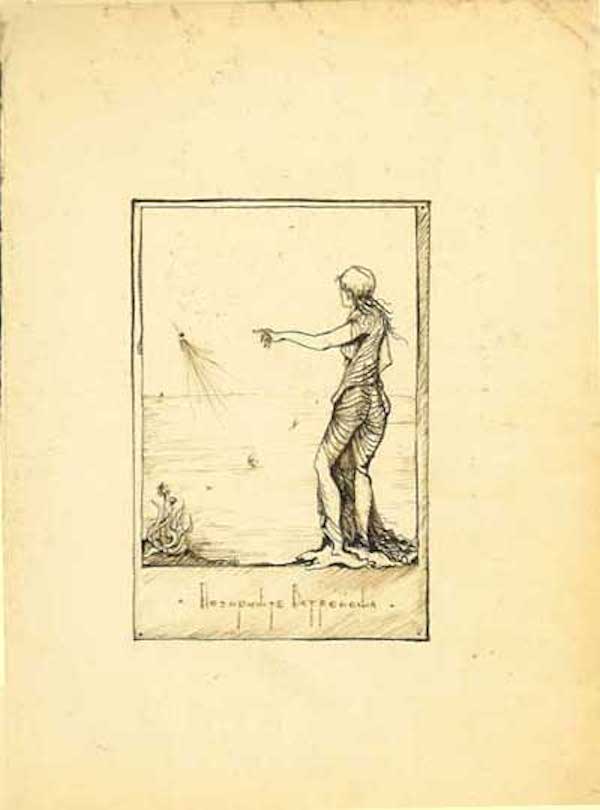

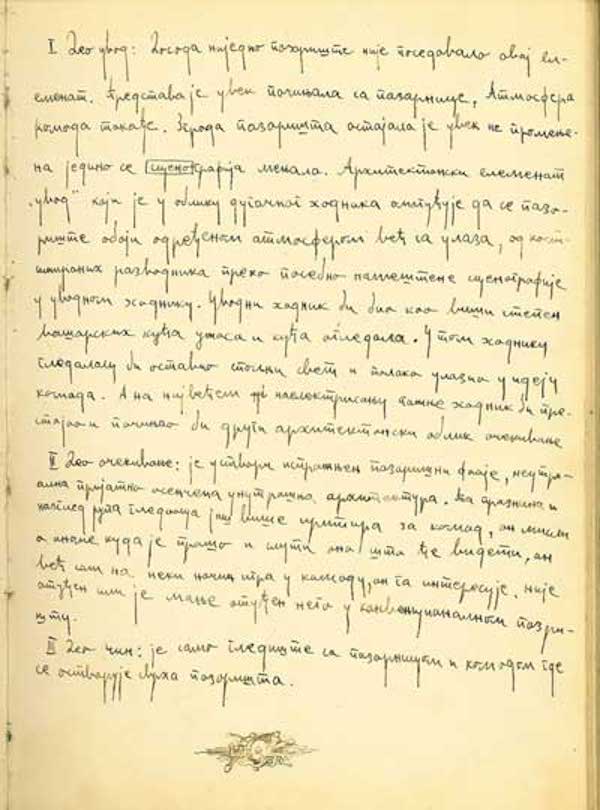
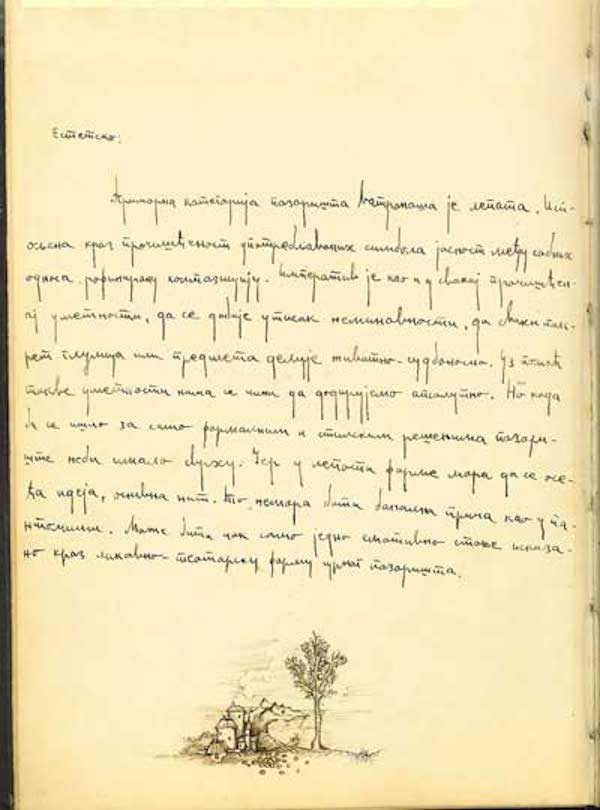
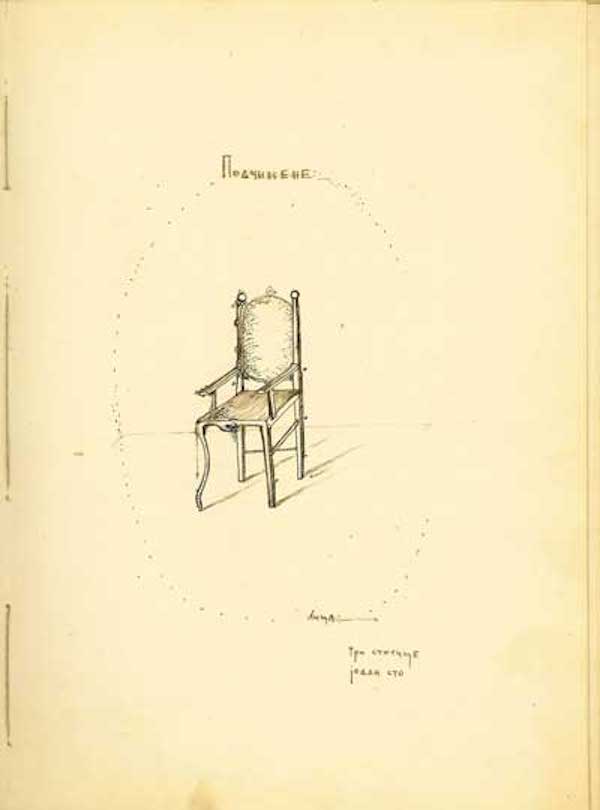
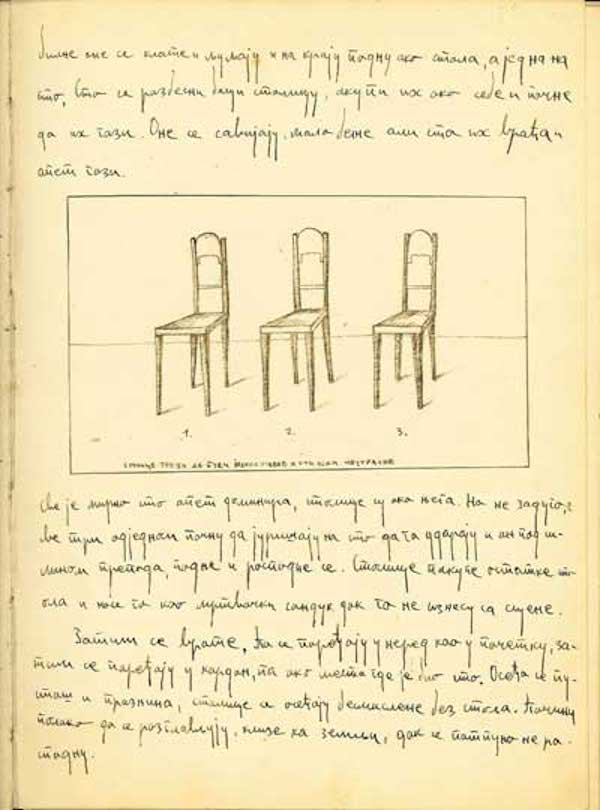


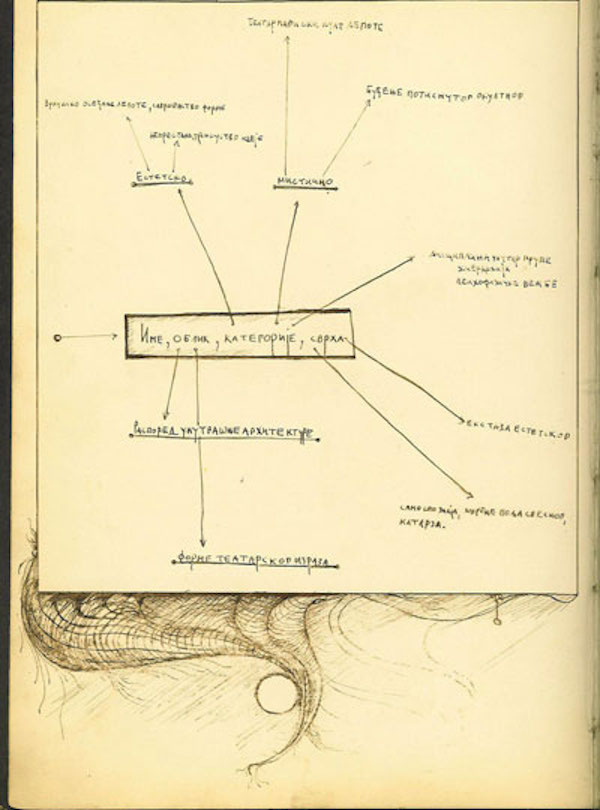
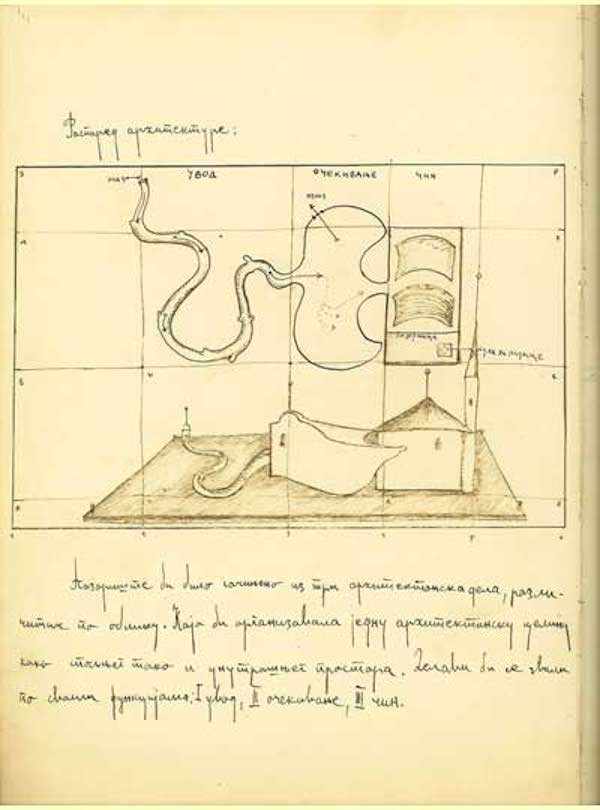
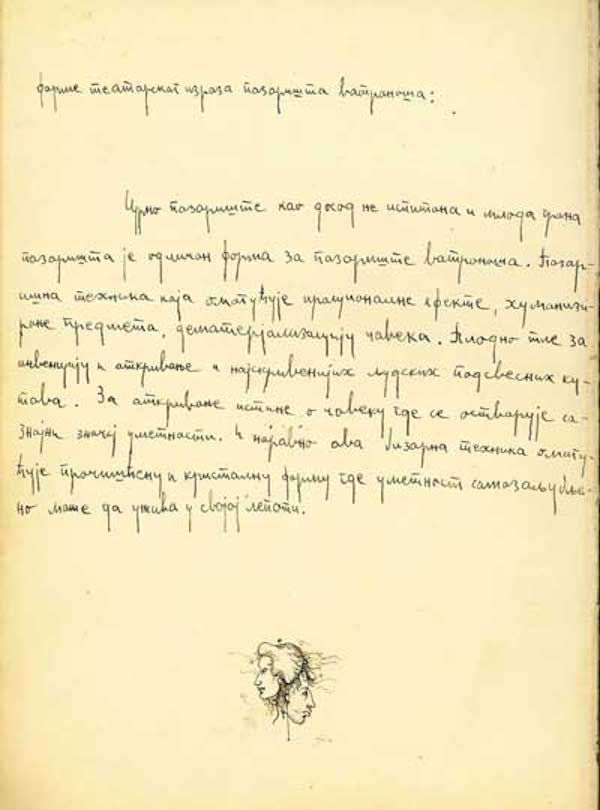



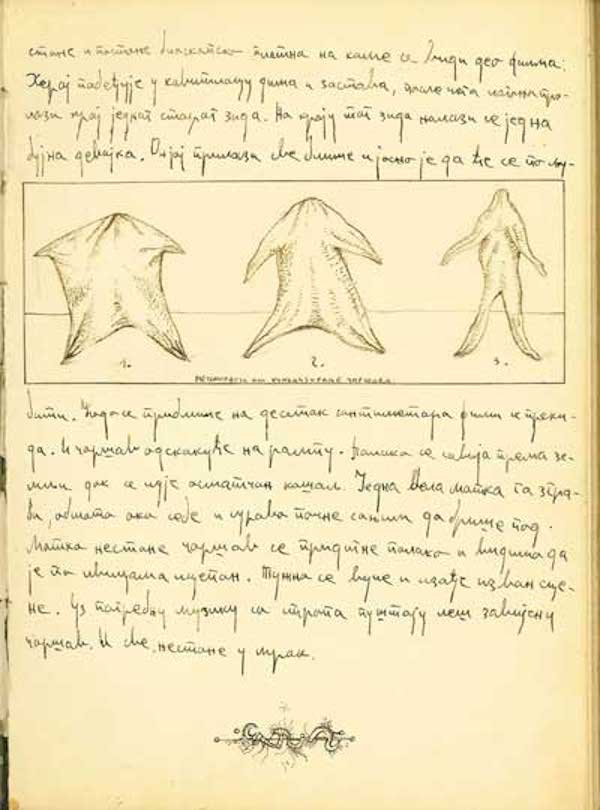
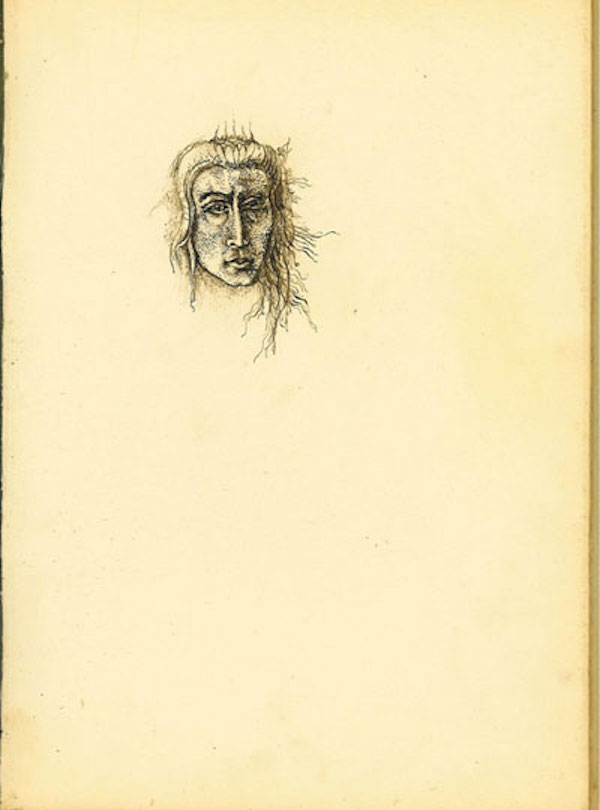
II. Serbian Text
POZORISTE VATRONOŠA
Ime.
Vatronoša, epitet Prometeja covekoljubca, koji je bogovima oteo vatru i darovao je ljudima. Vatru simbol prosvetljenja i mudrosti. Vatru koja je jedno od ishodista progresa covecanstva. Na starogrckom vatronosa se kaze pirforos (pyrforos), na latinskom lucifer. Lucifer kao simbol zla i pada kao simbol prokletstva naizgled nema nikakve veze sa Prometejem. No vatronosa Prometej i vatronosa Lucifer su iste licnosti. Ako uporedimo anticku pricu i biblijsku legendu videcemo: Jedan se polubog, Prometej, usudio da dirne u bozju sujetu i zato je morao da ispasta i na kraju je bio bacen u Had. Jedan je andjeo, Lucifer, hteo da bude velik koliko i Bog i za kaznu zbog sujete bio je bacen u pakao. Vatronosa je simbol najveceg uzdizanja, ponosa i darezljivosti, kao i pada i sujete. Pozoriste Vatronosa obraca se coveku koji u sebi nosi i Prometeja i Lucifera.
Oblik
Raspored arhitekture:
Pozoriste bi bilo sacinjeno iz tri arhitektonska dela, ralicita po obliku. Koji bi organizovali jednu arhitektonsku celinu kako spoljnjeg, tako i unutrasnjeg prostora. Delovi bi se zvali po svojim funkcijama: I uvod, II ocekivanje, III cin.
I Deo uvod: Do sada nijedno pozoriste nije posedovalo ovaj elemenat. Predstava je uvek pocinjala sa pozornice. Atmosfera komada takodje. Zgrada pozorista ostajala je uvek nepromenjena jedino se scenografija menjala. Arhitektonski elemenat «uvod» koji je u obliku dugackog hodnika omogucuje da se pozoriste oboji odredjenom atmosferom vec sa ulaza, od kostimiranih razvodnika preko posebno namestene scenografije u uvodnom hodniku. Uvodni hodnik bi bio kao visi stepen vasarskih kuca uzasa i kuca ogledala. U tom hodniku gledalac bi ostavio spoljni svet i polako ulazio u ideju komada. A na najvecem naelektrisanju paznje hodnik bi prestajao i pocinjao bi drugi arhitektonski oblik ocekivanja.
II Deo ocekivanje: je u stvari ispraznjen pozorisni foaje, neutralna prijatno osencena unutrasnja arhitektura. Ta praznina i naizgled rupa gledaoca jos vise intrigira za komad, on misli o onome kuda je posao i sluti ono sto ce videti, on vec sam na neki nacin igra u komadu, on ga interesuje, nije otudjen ili je manje otudjen nego u konvencionalnom pozoristu.
III Deo cin: je samo gledaliste sa pozornicom i komadom gde se ostvaruje svrha pozorista.
Forme teatarskog izraza pozorista Vatronoša:
Crno pozoriste kao do sad neispitana i mlada grana pozorista je odlicna forma za pozoriste Vatronosa. Pozorisna tehnika koja omogucuje iracionalne efekte, humaniziranje predmeta, dematerijalizaciju coveka. Plodno tle za invenciju i otkrivanje i najskrivenijih ljudskih podsvesnih kutova. Za otkrivanje istine o coveku gde se ostvaruje saznajni znacaj umetnosti. I naravno ova bizarna tehnika omogucuje prociscenu kristalnu formu gde umetnost samozaljubljeno moze da uziva u svojoj lepoti.
Kategorije.
Estetsko
Primarna kategorija pozorista vatronosa je lepota. Ispoljena kroz prociscenost upotrebljavanih simbola, jasnost medjusobnih odnosa, rafiniranu kompoziciju. Imperativ je kao i u svakoj prociscenoj umetnosti da se dobije utisak neminovnosti, da svaki pokret glumca ili predmeta deluje zivotno-sudbonosno. Uz pomoc takve umetnosti nama se cini da dodirujemo apsolutno. No kada bi se islo samo za formama i stilskim resenjima pozoriste ne bi imalo svrhu. Jer u lepoti forme mora da se oseca ideja, osnovna nit. To ne mora biti banalna prica kao u pantomimi. Moze biti cak samo jedno emotivno stanje iskazano kroz likovno-teatarsku formu crnog pozorista
Misticno:
Vreme u kome zivimo upinje se da razotkrije i ogoli tajne. Nauka rusi tajne dokazujuci postojanje uzroka svim stvarima i pojavama. No lepoti je potrebna tajna, kao sto je svakom coveku potrebna i lepota i tajna. Umetnosti i kad zna, nece da zna, i kad vidi ona iskrivljuje. Ali zato ona voli, ona hoce da primi i da od sebe da, ona je covecnija i emotivnija od ma koje istine nauke. Progres nauke i tehnicki progres covecanstva su velika stvari, ali nebitna za krajnje estetsko. Iako su stari narodi videli magijsko i misticno u umetnosti i imali razvijen osecaj za okultnost umetnickog izraza, mi danas uglavnom gledamo umetnost otudjeno i neprestano smo izvan nje. Misli se da je seansa i religiozna predstava anahronizam, i jeste ako prizivamo duhove. Ali seansa prizivanja sebe sama, to je potrebnije coveku danas vise nego ikad. Crno pozoriste u svojoj razvijenoj formo to moze da mu pruzi.
Podcinjenje
Lica:
Tri stolice
Jedan sto
Na potpuno crnu scenu ulazi jedna bela stolica. Malo usporena, malo troma muzika tumaci njen karakter. Zatim iza nje ulazi druga potpuno ista bela stolica, samo veselije i zivahnije. A zatim treca uz gegavu skoro copavu muziku.
Kada su usle poredjaju se u nered svaka na svoju stranu scene. Tako malo stoje, no iznenada kroz muziku cuju da nesto dolazi. Pocinju da se postrojavaju.
Uz trijumfalni mars ulazi jedan beli sto i obilazi kordon poredjanih stolica. Zatim stane na sredinu scene a stolice zaplasene poredjaju se oko stola. Iz njihovog polozaja vidi se da sto dominira.
No to ne traje dugo, stolice se naginju jedna drugoj, nesto se dogovaraju. Pa onda jedna pocne da se penje na sto, i jedva se nekako popne, nesto se dogovaraju. Pa onda jedna pocne da se penje na sto, i jedva se nekako popne, a sto je odbaci. Onda pocnu druge dve ali bez uspeha. Zatim se malo izmaknu i popnu jedna na drugu da bi makar tako bile vise od stola, no buduci da su u tom polozaju nestabilne, one se klate i ljuljaju i na kraju padnu oko stola, a jedna na sto. Sto se razbesni, baci stolicu, okupi ih oko sebe i pocne da ih gazi. One se savijaju, malo beze, ali sto ih vraca i opet gazi.
Sve je mirno, sto opet dominira, stolice su oko njega. No ne zadugo, sve tri odjednom pocnu da jurisaju na sto, da ga udaraju i on pod silinom prepada padne i raspadne se. Stolice pokupe ostatke stola i nose ga kao mrtvacki sanduk dok ga ne iznesu sa scene.
Zatim se vrate. Pa se poredjaju u nered kao u pocetku, zatim se poredjaju u kordon, pa oko mesta gde je bio sto. Oseca se pustos i praznina, stolice se osecaju besmislene bez stola. Pocinju polako da se razglavljuju, klize ka zemlji, dok se potpuno ne raspadnu.
Zivotni put
Lice: Jedan carsav
Cuje se plac bebe, na pozornici je jedna bela, horizontalna linija. Ta linija pocinje da se ugiba i vidi se da je to carsav, slozen i lepo ispeglan. On se dalje razvija sve dok ne poraste do pravougaonika normalnog carsava. Dve gornje ivice pocnu da asociraju na ruke, a dve donje ivice na noge, a jedno ispupcenje na vrhu – glava. Tako humaniziran carsav pocne da igra kao balerina, zatim stane pa se ceska po glavi, pa iza vrata, pa po ledjima. Cese se kao da je pun buva. Odjednom, cuju se uzvici gomile, aplauz, carsav gestikulira kao govornik, busa se u grudi. No, ta igra prestaje i carsav uz muziku punu zivotne radosti leti kroz prostor praveci razne apstraktne figure: uvija se spiralno, zatim leti kao kometa praveci parabolu. Leprsanje krajeva naglo se pretvara u geometrijske slike. Odjednom, carsav pocinje da sluzi. Uz svadbeni mars prelazi preko scene kao nevestin veo noseci buket cveca u ruci i venac na glavi. Buket i venac nestanu i carsav se baci preko necega i vidimo da je postao stolnjak. Na njemu se odjednom nadju case, flase i tanjiri. Cuje se mljackanje i zveckanje koje se iznenada pretvara u fijukanje vetra, carsav se podigne da bi u iducem trenutku pao preko scene kao jedro. Kad stigne na drugi kraj scene naglo stane i postane biospopsko plano na kome se vidi deo filma.
Heroj pobedjuje u kovitlacu dima i zastava, posle cega lagano prolazi kraj jednog starog zida. Na kraju tog zida nalazi se jedna bujna devojka. On joj prilazi sve blize i jasno je da ce se poljubiti. Kada se priblize na desetak santimetara film se prekida. I carsav odskakuce na rampu. Jedna bela motka ga zgrabi, obmota oko sebe i surovo pocne njime da brise pod. Motka nestane, carsav se pridigne polako i vidimo da je po ivicama iscepan. Tuzno se vuce i izadje van scene. Uz pogrebnu muziku sa stropa pustaju les zavijen u carsav. Sve nestane u mrak
KRAJ TEKSTA
SLOBODAN DAN PAICH
III. English Text
VATRONOŠA
THE FIRE-BRINGER THEATRE
Name.
Fire-Bringer is the epithet of Prometheus, lover of mankind, who stole fire from gods and gave it to humans. Fire – a symbol of enlightenment and wisdom. Fire – one of the sources of the progress of mankind. In Ancient Greek the word for fire-bringer is πυρφορος and in Latin it is Lucifer. Lucifer – as a symbol of evil and fall, a symbol of curse - seemingly has nothing to do with Prometheus. But Prometheus the fire-bringer and Lucifer the fire-bringer is one and the same person. When we compare the ancient myth and the biblical legend we see: a demigod, Prometheus, dared defy the divine vanity, was made to expiate and was finally cast into Hades. An angel, Lucifer, wanted to emulate God in his greatness and was cast into hell in punishment for his vanity. The fire-bringer is a symbol of the greatest ascent, pride and generosity as well as a symbol of the fall and vanity. The Fire-Bringer Theatre addresses man who carries within both Prometheus and Lucifer.
Shape.
Architectural arrangement:
The theatre would be made of three architectural parts, differently shaped, to create an architectural entity of both the outer and the inner space. The parts would be named after their function: I Introduction, II Expectation, III Act.
I Part Introduction: No theatre has included this element so far. A performance always started on the stage. The same holds true of the atmosphere of a play. The theatre building was always the same and only the sets changed. The architectural element “Introduction”, in the shape of a long passageway, colours the theatre with a certain atmosphere right from the entrance, from ushers in costumes to purposefully arranged sets in the introductory passage. The introductory passage would look like more sophisticated houses of horror and houses of mirrors one sees at fairs. And when the attention is at its keenest, the passage would end and the second architectural shape of expectation begin.
II Part Expectation: It is, in fact, an emptied theatre lobby, a neutral, agreeably shaded interior architecture. The emptiness and the apparent hole arouse further the curiosity of the spectator; he thinks about where he/she is heading and guesses at what he/she is going to see. The spectator thus, in a way, becomes another character in the play, it interests him/her; he/she is not alienated or at least is less alienated than in a conventional theatre.
III Part: Act: It is only the house with the stage and the play where the purpose of the theatre is fulfilled.
Forms of the theatrical expression of the Fire-Bringer Theatre
The black theatre, as a young and as yet uncharted theatre territory, is an excellent form for the Fire-Bringer Theatre. It is the theatrical technique making possible irrational effects, humanisation of objects, dematerialisation of man. It is fertile soil for inventiveness and discovery of man’s innermost subconscious crannies; for the discovery of the truth about man where the cognitive significance of art is materialised. And, needless to say, this bizarre technique enables a purified crystal form in which art can indulge in the enjoyment of its own beauty.
Categories.
Aesthetical:
The primary category of the Fire-Bringer Theatre is beauty, manifested in the purity of the symbols used, the clarity of mutual relations, sophisticated composition. As in any kind of purified art, it is imperative to gain the impression of inevitability, to have every move of an actor or object look vital and fateful. It seems to us that with the help of such art we touch the absolute. Theatre would serve no purpose however if one pursued only forms and style. Idea, that basic thread needs to be sensed in the beauty of form. It need not be a banal story as in the pantomime. It can even be but an emotional state expressed through the graphic-theatrical form of the black theatre.
Mystical:
The time we live in struggles to reveal and expose the secrets. Science undermines secrets proving that there is a cause for every thing and every phenomenon. Beauty however, needs a secret just as every man needs both beauty and secret. The art, even when it knows, does not want to know; even as it sees, it distorts. But, on the other hand, it loves, it is ready to receive and give, it is more humane and more emotive than any scientific truth. The scientific and technological progress of the humankind is great but irrelevant for the ultimate aesthetic. Even though ancient peoples saw the magic and mysticism in art and had a developed sense of the occult nature of the artistic expression, today we mostly watch art as something alienated from us and we are always outside it. It is thought that séance and religious performance are anachronistic and so they are if we are summoning the spirits. But man needs the séance in which we summon ourselves more than ever before. In its developed form the black theatre can give him that.
Subjugation
Characters:
Three chairs
A table
A white chair enters the black stage. Music, a little slow, a little wan, interprets the chair’s character. Then another, identical white chair enters, but at a merrier and livelier pace. And then the third to waddling, almost limping music.
Having entered, they deploy in disorder, each in a different part of the stage. They stand like that for a little while and then, suddenly, over the music, they hear something coming. They start to align themselves.
To the sounds of a triumphal march a white table enters and reviews the cordon of aligned chairs. Then it stops in the centre of the stage and frightened chairs take their places around it. Their position shows that the table is dominant.
This does not last long however. The chairs lean one towards the other and discuss something. Then one begins to climb the table and somehow manages to do it but the table throws it off. Then the other two set off and fail. They move away a little and mount one another and thus become higher than the table but being unstable in that position, they sway and wobble and finally fall around the table whilst one ends up on the table. The table is enraged; it throws the chair off, then brings them all around and starts trampling on them. They bend, flee, but the table brings them back and tramples on them again.
Everything is quiet, the table holds sway again, and the chairs are around it. Not for long however because all three suddenly charge the table, beat it and under their violent assault it falls over and breaks into pieces. The chairs collect the pieces and carry it like a coffin off the stage.
Then they come back, position themselves haphazardly as before, yet again form a cordon and then gather around the place where the table stood. Desolation and emptiness - the chairs feel purposeless without the table. They begin to fall apart, slide towards the ground and finally break down completely.
A Life
Character: A bed-sheet
A baby is crying somewhere; there is a white horizontal line on the stage. The line begins to curve and one sees that it is a white bed-sheet, folded and well-ironed. It continues to unfold until it becomes the rectangle of a common bed-sheet. The two upper edges are remindful of arms and the two lower ones of legs; the bulge on top – a head. The humanised sheet begins to dance like a ballerina, then it scratches its head, the back of the neck, then the back. It scratches as if it were full of fleas. Suddenly, the sounds of a crowd, applause, the sheet gesticulates as a speaker, pounds its chest. That game stops and to the accompaniment of lively music the sheet flies through the air and forms various abstract figures: it twists in a spiral, then flies as a comet creating a parabola. The fluttering edges unexpectedly turn into geometrical figures. Out of the blue the sheet begins to ooze mucus. To a wedding march it crosses the stage like a bridal veil carrying a bunch of flowers in its hand and a wreath on its head. The bunch of flowers and the wreath disappear and the sheet pounces upon something and we see that it has become a table-cloth. Suddenly glasses, bottles and plates appear on it. Chewing and clinking are heard only to turn suddenly into the howl of the wind; the sheet rises but the next moment it drops on the stage like a sail. When it reaches the other end of the stage, it abruptly stops and becomes a projection screen showing a fragment of a film.
The hero wins in a whirl of smoke and flags, after which he walks slowly along an old wall. There is a luscious girl at the end of the wall. He approaches her ever closer and it is clear that they will kiss. When they are only some 10 centimetres apart the film stops and the sheet hops to the ramp. A white pole snatches it, wraps itself with it and begins to fiercely mop the floor with it. The pole disappears, the sheet slowly heaves itself up and we see that its edges are torn. It drags itself sadly to the exit. To the funereal music a dead body wrapped in a sheet is lowered from the flies. Everything disappears in the darkness.
END OF THE TEXT
SLOBODAN DAN PAICH
IV. The members of the group
Members of Theater Vatronosa
Performers:
- Evgenija Demnievska
- Ivana Golubovic
- Rastko Jovanovic
- Vlada Lazarevic
- Predrag Vitas
- Bozidar Zecevic
Tamara Polonska, Ballet mistress of Belgrade National Theater lead weekly exercises and classes of the company.
Nebojsa Stojanovic, Logistics and technical support.
Slobodan Dan Paich was convener, director/ movement maker of the company.